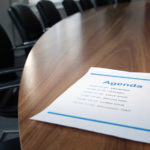The agenda is a powerful tool for helping the board attend to what matters. The chair uses the agenda to help the board accomplish its work, make the best use of time, and filter out extraneous topics. Having the agenda at least a week in advance allows directors to plan local travel, read relevant documents, and begin thinking about issues to be discussed. The agenda provides staff with direction on what facilties and equipment to provide, what data might be needed, and what questions may be asked. Here are five parts of a meeting agenda for nonprofit boards that help make these things possible:
Board Meetings
What If All Your Agenda Items Were Good Questions?
To help board members engage in decisions and focus discussions on governance, try framing all agenda items as questions.
Show Your Board How to Do More and Waste Less
What do board members need to be effective? Here are five ways to enhance board productivity with less paper waste.
5 Ways to Make a Better Agenda for Board Meetings
An agenda is the primary tool of effective board meetings. The agenda keeps the board focused on appropriate information for making decisions and monitoring performance. The board’s governance policies or bylaws may determine overall board process, but it’s the agenda that determines how intended outcomes engage with current performance during the meeting. Here are 5 ways to have a better agenda for board meetings . . .



